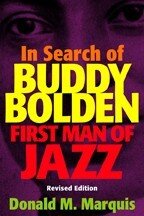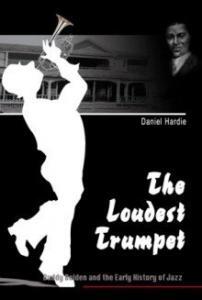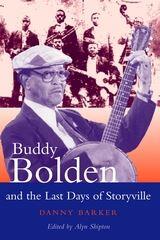The title of this article is a bit of a misnomer. If you want to read about Louis Armstrong there are several long and worthwhile biographies, but if you want to learn the nuts and bolts of Buddy Bolden’s life there is truly only one.
In Search of Buddy Bolden: First Man of Jazz, by Donald M. Marquis
 In 1978, after years of research, Donald M. Marquis released In Search of Buddy Bolden: First Man of Jazz. The book itself has become a model of how historical research should be done. The journal Marquis kept while preparing the book was published separately as Finding Buddy Bolden and is still assigned to graduate students in history as a benchmark to aspire to.
In 1978, after years of research, Donald M. Marquis released In Search of Buddy Bolden: First Man of Jazz. The book itself has become a model of how historical research should be done. The journal Marquis kept while preparing the book was published separately as Finding Buddy Bolden and is still assigned to graduate students in history as a benchmark to aspire to.
As he was preparing to write his own history of Buddy Bolden, Michael Ondaatje was confronted with the publication of this landmark and opted instead to write a well-received fictional account of Bolden’s life called Coming Through Slaughter. Other writers have taken the same strategy and Bolden now appears as a character in several novels.
As monumental as In Seach of Buddy Bolden was, it only ran to about 150 pages. There just isn’t that much that can be known about a black man in the south who after 1907 was confined to a psychiatric facility. Because bits and pieces of new information do occasionally pop up and Marquis became less sure of certain of his conclusions over time he revised his book in 2005 with about 20 pages of new material, some of it very interesting.
Much of the book serves to dispel certain legends about Buddy Bolden that grew out of errors in a 1939 oral history called Jazzmen. The most persistent of these are that Bolden owned a barbershop and that he published a gossip magazine called The Cricket.
Marquis goes to great lengths dispelling the barbershop myth. First-hand accounts all report, proudly, that Bolden lived solely off making music after around 1900, and before that, while still a very young man, worked only briefly as a plasterer. A close friend and member of his band did own a barbershop and that is likely the source of the rumor. Bolden and his bandmate, Louis Jones, were said to drink heavily together and have many girlfriends. As they both had wives at home my theory is that the barbershop was their hide-a-way and might well have seemed like Bolden’s place to some visitors.
The Cricket story has become more interesting over time. In 1978 there was no evidence such a paper existed, but in the years since, as detailed in the revised edition, several issues have been unearthed dating to the late 1890s. While Buddy Bolden was certainly not the proprietor there is an intriguing contemporaneous arrest record of a Bolden giving his occupation as “Reporter.”
You will notice that none of this is about the music that Buddy Bolden made. Marquis does not spend much effort on musical guesswork. To the extent possible he considers Bolden’s schooling and early exposure to music, especially church music. He identifies as many band members as he can, and he contrasts the Buddy Bolden band with others working at that time. He goes into block by block detail of certain neighborhoods and list venues at which Bolden played and when. He contemplates his personality and traces his family several generations into history and up to the present day. He also chronicles his illness and institutionalization.
The chapter, late in the book, titled “How And What He Played” is only 12 pages long. It makes some educated guesses at the Bolden sound and compiles a list of songs that his band performed. It is enough for a reader primarily interested in biographical details.
The Loudest Trumpet by Daniel Hardie
 To get the rest of the story you’ll need to read The Loudest Trumpet by Daniel Hardie. The book can be seen as a sequel to or expansion of In Search of Buddy Bolden. The first chapters refresh the reader on the biographical details unearthed by Marquis, but the bulk of 220 pages are devoted to a richly detailed investigation of the musical environment around him, and an attempt to identify his true place in the history of jazz.
To get the rest of the story you’ll need to read The Loudest Trumpet by Daniel Hardie. The book can be seen as a sequel to or expansion of In Search of Buddy Bolden. The first chapters refresh the reader on the biographical details unearthed by Marquis, but the bulk of 220 pages are devoted to a richly detailed investigation of the musical environment around him, and an attempt to identify his true place in the history of jazz.
Using plain language to describe musical topics, Hardie explains to the lay reader the importance of clues about Bolden’s playing. For example, he analyzes a suggestion from a formally trained “Creole” musician that the Bolden band only played in B flat, essentially the open tuning of most clarinets, and therefore the easiest to “fake”. Hardie grants him E flat and F natural as well. Both are also keys that would be easy for non-reading musicians to play, and Hardie discusses the respect for improvising musicians that began to develop during this time.
He also analyzes the two clarinets, cornet, valve trombone frontline of Bolden’s band for clues to their sound. How much improvising was really going on? Was one clarinet doubling the melody while the other “faked”? Were they in the same key? Some describe Bolden as a “sweet” player on his cornet, many others say he was powerful and loud. Hardie finds clues in Bunk Johnson’s descriptions from the 40s, and in King Oliver and Freddie Keppard’s recordings from the 20s.
He also traces the standard instruments found in other New Orleans bands from the 1890s up to the jazz revival and the result is illuminating. I have a print of the famous 1921 King Oliver’s Creole Jazz Band photograph on my wall. I’d never considered the significance of the band having both a violin and a saxophone. What is considered the standard instrumentation of a traditional jazz band was rarely heard outside of a studio in the 20s.
Hardie finds the piano largely absent from black bands until the late teens, with the piano’s role being played by the violin, but in contrast, white bands frequently had pianos and only started using violins in the 20s. Mandolins and guitars filled the role that banjos would eventually play before guitars would again dominate, and double bass was standard before the tuba became prominent, until of course, the bass returned to the fore. Bolden’s main contribution may have been to make the cornet central to the leadership of a band, but one band active in the immediate wake of Bolden’s departure from the scene was led by a piccolo!
He concludes that Bolden has an almost unique place in jazz. His band played a rough and bluesy improvisational style shortly before the New Orleans scene absorbed the national sound of formal ragtime scores. Hardie describes the sound of the period after Bolden, but before what would be now understood as jazz, “Free-Ragtime”, a term I find marvelous.
Hardie makes a best guess at Bolden’s sound, don’t worry, if you aren’t familiar with everyone named you will be by the time you reach this point in the book:
“Bolden must have sounded like a younger Wooden Joe with some of Keppard’s flair, and played the blues like Bunk only sweeter; an overall sound not unlike the sound Mutt Carey was to carry well into the 1940s. It was not yet the punchy restrained sound developed by King Oliver and Louis Armstrong.”
If you find the preceding paragraphs fascinating The Loudest Trumpet is a must-read book for you. Hardie has done his homework, he is familiar with all of the writers that have approached these topics in the past and cognizant of their biases and controversies. To put his own ideas in perspective, he discusses the ideas of Rudi Blesh, Gunther Schuller, Frank Tirro, and others. As a non-academic discussion of what makes New Orleans jazz what it is this book is hard to top.
Buddy Bolden and the Last Days of Storyville, by Danny Barker
 One other book needs to be mentioned because you will see it as you search for books about Buddy Bolden. The late great Danny Barker collected the history of New Orleans jazz over many decades and wrote a wonderful autobiography, A Life in Jazz. You will also find under his name a book titled Buddy Bolden and the Last Days of Storyville. It collected some of his other writing shortly after his passing. Only the first 50 pages concern Buddy Bolden.
One other book needs to be mentioned because you will see it as you search for books about Buddy Bolden. The late great Danny Barker collected the history of New Orleans jazz over many decades and wrote a wonderful autobiography, A Life in Jazz. You will also find under his name a book titled Buddy Bolden and the Last Days of Storyville. It collected some of his other writing shortly after his passing. Only the first 50 pages concern Buddy Bolden.
The long chapter titled “A Memory of King Bolden” was first published in the early 60s, presented as the record of an interview between Barker and the younger brother of one of Bolden’s bandmates. The account is a largely, possibly entirely, a fictional one. He uses this storytelling format to incorporate oral history he had gathered about Bolden from other sometimes questionable sources, including Bunk Johnson and Jelly Roll Morton.
Most people at the time believed Bolden ran a barbershop, so much of the narrative revolves around events there. It follows a general timeline of Bolden already in his prime around 1900 until he is eventually confined after dropping out halfway through a labor day parade.
As a piece of storytelling, it is a true work of art, combining the myth of the man with real memories of his environment. Lincoln Park, a primary venue for the Bolden band, is described in vivid detail. Tales of Buddy Bottley, “The Colored Aeronaut” who launched a primitive hot air balloon from the park may lack in fact, but were likely stories told in the neighborhood. The book is valuable as a testament to how Buddy Bolden was remembered within his community at a certain point in time, and a glimpse at what his community was like, but don’t buy it looking for the real story.
For the facts of Bolden’s life find the revised edition of Marquis’ book. To learn how Bolden’s brief reign as the King of New Orleans syncopated music set the ball rolling for the jazz age, The Loudest Trumpet is the book for you.
More on Bolden
Joe Bebco is the Associate Editor of The Syncopated Times and Webmaster of SyncopatedTimes.com






















